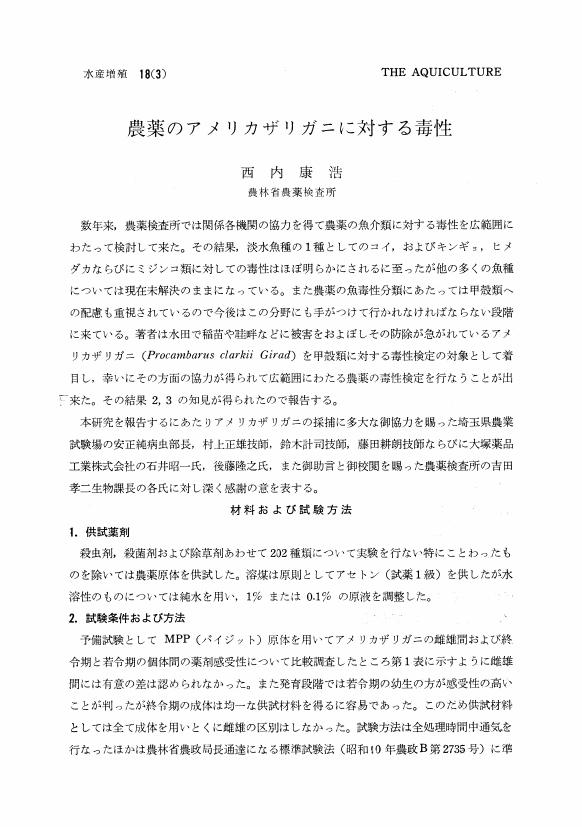1 0 0 0 OA 魚類の椎体数
- 著者
- 西内 康浩
- 出版者
- 日本水産増殖学会
- 雑誌
- 水産増殖 (ISSN:03714217)
- 巻号頁・発行日
- vol.22, no.1, pp.19, 1974-06-25 (Released:2010-03-09)
1 0 0 0 OA 農薬のアメリカザリガニに対する毒性
- 著者
- 西内 康浩
- 出版者
- Japanese Society for Aquaculture Science
- 雑誌
- 水産増殖 (ISSN:03714217)
- 巻号頁・発行日
- vol.18, no.3, pp.121-132, 1970-08-30 (Released:2010-03-10)
- 参考文献数
- 8
1 0 0 0 OA 農薬の水生動物に対する毒性試験法の確立
- 著者
- 橋本 康 西内 康浩
- 出版者
- 日本農薬学会
- 雑誌
- Journal of Pesticide Science (ISSN:1348589X)
- 巻号頁・発行日
- vol.6, no.2, pp.257-264, 1981-05-20 (Released:2010-08-05)
- 参考文献数
- 27
- 被引用文献数
- 32 40
“The standard method for the evaluation of acute toxicity of pesticides to fish” and “A method for the evaluation of acute toxicity of pesticides to daphnids” were established to give 48h TLm values for carp and 3h TLm values for Daphnia pulex or Moina macrocopa. With these and some modified methods, acute toxicity of all the already registered pesticides to carp and daphnids were evaluated, and factors influencing the toxicity of pesticides or sensitivity of test organisms to pesticides were investigated. The results are summarized as follows: (1) Rotenone and organochlorine insecticides, organomercurial, organotin, dimethyl dithiocarbamate and phthalimide fungicides, dinitrophenol and pentachlorphenol herbicides have high toxicity to carp, while organophosphorus and phenylcarbamate insecticides are extremely toxic to daphnids. (2) In general, emulsifiable concentrates, technical products, wettable powders, dust and granules are toxic to carp, in this order. (3) The majority of pesticides are more toxic to carp and daphnids at higher temperatures, but some, including folpet and DDT, are less toxic to carp and daphnids, respectively, at higher temperatures. (4) The majority of pesticides are less toxic at higher pH. (5) No apparent synergism or antagonism is observed to occur between 6 pairs of organophosphorus and phenyl carbamate insecticides with carp. (6) No remarkable change in sensitivity of carp is observed with growth to 6 pesticides, including organophosphorus insecticides and pentachlorphenol herbicide, although sensitivity to endosulfan insecticide is extremely high at earlier developmental stages after floating. (7) Dietary pesticides are in general less toxic to carp than pesticides in bath exposure systems. In addition, sensitivity of other aquatic organisms to pesticides was evaluated by the recently developed method. Results are summarized as follows: (1) Gold fish, tanago; Rhodeus moriokae, dojo; Misgurnus anguillicaudatus, and medata; Oryzias latipes, have sensitivity similar to carp. (2) Larvae of dragonfly; Orthetrum albistylum speciosum, and mayfly; Cloëon dipterum, are found to have lower sensitivity than daphnids, but the correlations of TLm values among them are comparatively high. (3) The molluscean animals, Indoplanorbis exustus, Cipangopaludina chinensis malleata, Semisulcospira libertine and Physa acuta have low sensitivity to pesticides in general. (4) Tadpoles of Bufo bufo japonicas, Rana brevipoda and Rana catesbeiana have low sensitivity to pesticides in general.
1 0 0 0 OA 各種農薬のドジョウに及ぼす影響-I
- 著者
- 西内 康浩 吉田 孝二 橋本 康
- 出版者
- Japanese Society for Aquaculture Science
- 雑誌
- 水産増殖 (ISSN:03714217)
- 巻号頁・発行日
- vol.18, no.5-6, pp.227-235, 1971-03-30 (Released:2010-06-30)
- 参考文献数
- 38
- 被引用文献数
- 1
1. ドジョウおよびコイ稚魚にたいする農薬の影響をしらべ, 農薬にたいするこれら供試生物問の感受性の差異について比較検討した。2. 結果は供試した53種類の農薬にたいしてコイおよびドジョウは以下のような多少の相違は認められたが概して近似した感受性を示した。ドジョウの方がコイよりも高い感受性を示す薬剤しとてはアルドリン, テロドリン, ヘプタクロル, ベンゾエピン, DEP (デイプテレックス), ダイアジノン, PMP (PMP. アッパ), CBA (ミノコール) およびEDDP (ヒノザン) 等があげられ, ダイアジノンがやや著るしい傾向が認められ, これとは逆に, コイの方がドジョウより多少高い傾向にあるものとしてはEPNおよびTPN (ダコニール) が上げられ, コイの方が高いものとしてはMCPCA (マピカ) が上げられる。

